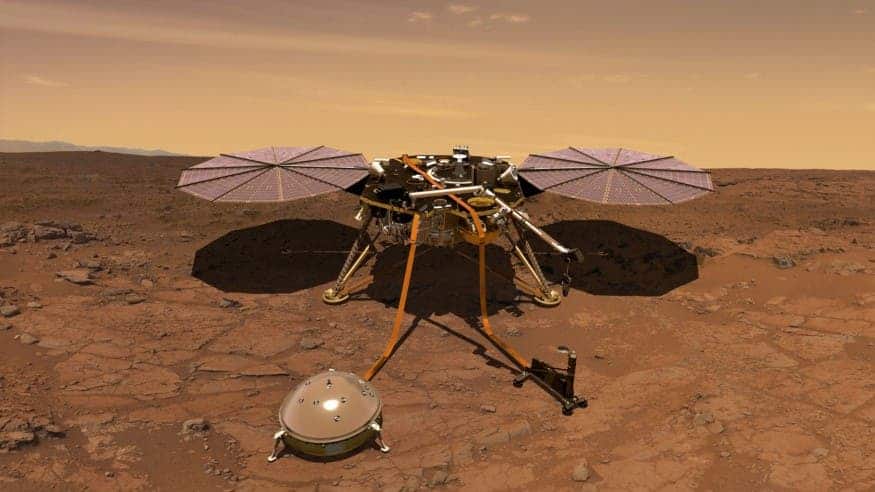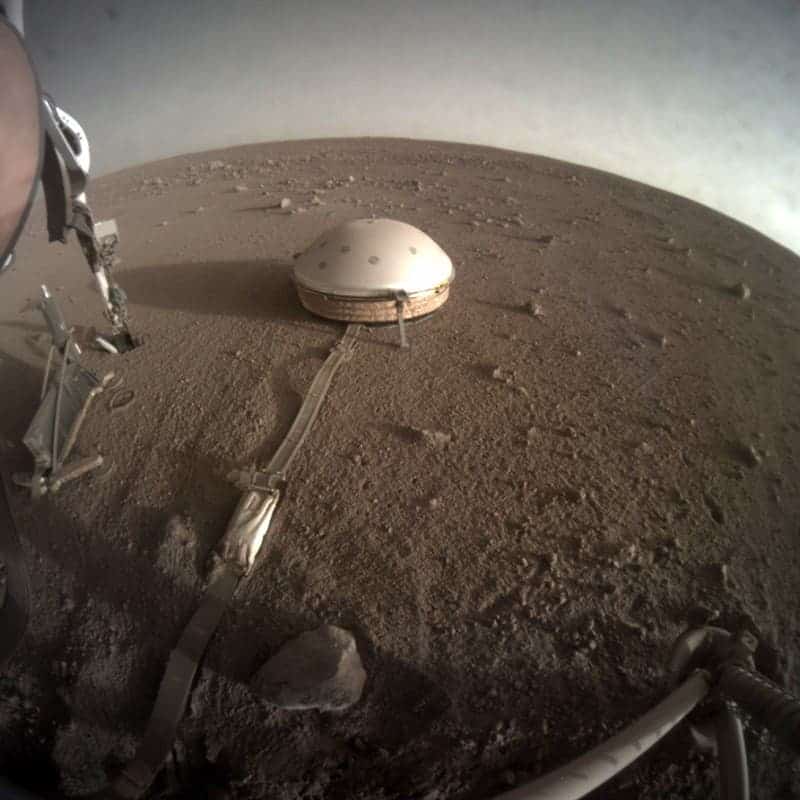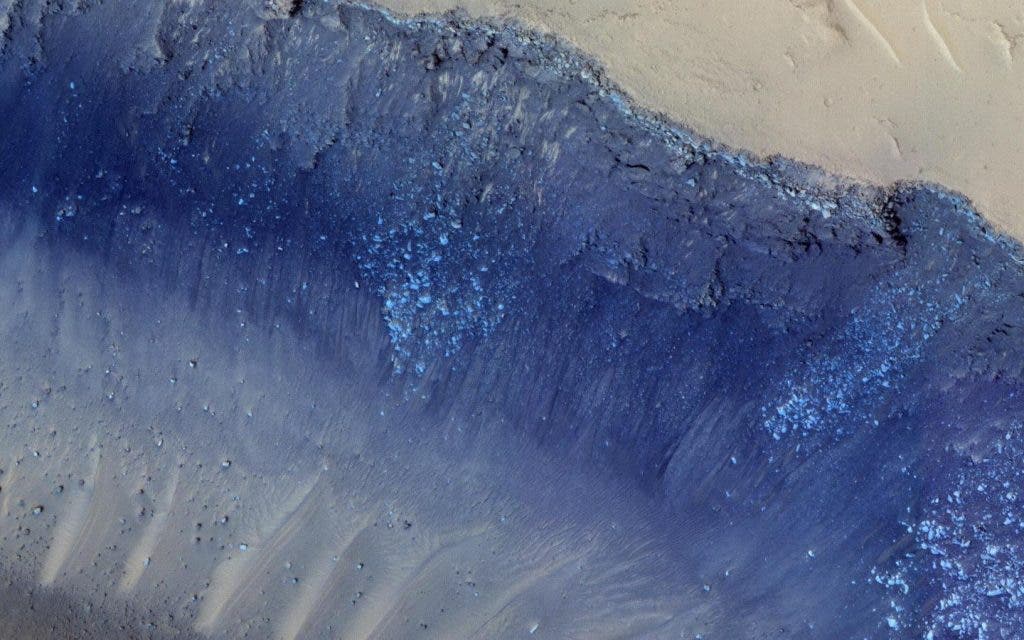We are closer than ever before to understanding the composition of Mars thanks to the first observations of seismic activity on the planet made by the InSight lander. The NASA-led project, which landed on the surface of the Red Planet in November 2018 with the goal of probing beneath the Martian surface, observed several so-called ‘marsquakes’ which reveal details about its crust, mantle, and core.

InSight’s primary findings which are detailed in three papers published today in the journal Science, represent the first time scientists have been able to produce a detailed picture of the interior of a planet other than Earth.
“We are seeking to understand the processes that govern planetary evolution and formation, to discover the factors that have led to Earth’s unique evolution,” says Amir Khan, ETH Zurich and the University of Zurich, whose team used direct and surface reflected seismic waves to reveal the structure of Mars’ mantle. “In this respect, the InSight mission fills a gap in the scientific exploration of the solar system by performing an in-situ investigation of a planet other than our own.”
The results from the ongoing NASA mission–with the full title ‘Interior Exploration using Seismic Investigations, Geodesy and Heat Transport’— could reveal key insights into the Red Planet‘s formation and evolution, as well as helping us understand the key differences between our planet and Mars.
One big question we would like to understand is why Earth is the only planet with liquid oceans, plate tectonics, and abundant life?” adds Khan. “Mars is presently on the edge of the solar system’s habitable zone and may have been more hospitable in its early history. Whilst we don’t yet know the answers to these questions, we know they to be found are on Mars, most likely within its interior.”

InSight first detected the presence of marsquakes from its position in Elysium Planitia near the Red Planet’s equator in 2019 and has since picked up more than 300 events–more than 2 a day–tracing many of them back to their source.
What is really impressive is what researchers can do with these quakes, using them as a diagnostic tool to ‘see’ deep into the planet’s interior.
“Studying the signals of marsquakes, we measured the thickness of the crust and the structure of the mantle, as well as the size of the Martian core,” Simon Stähler, a research seismologist at ETH Zurich, tells ZME Science. “This replicates what was done on Earth between 1900 and 1940 using the signals of earthquakes.”
From the Crust of Mars…
The observations made by InSight have allowed researchers to assess the structure of Mars’ crust, allowing them to determine its thickness and other properties in absolute numbers for the first time. The only values we previously had for the Martian crust were relative values that showed differences in thickness from area to area.
“As part of the bigger picture on the interior structure of Mars, we have determined the thickness and structure of the Martian crust,” Brigitte Knapmeyer-Endrun, a geophysicist at the University of Cologne’s Institute of Geology, tells ZME Science. “Previous estimates could only rely on orbital data–gravity and topography–that can accurately describe relative variations in crustal thickness, but no absolute values. These estimates also showed a wide variability.”

With data collected regarding the crustal thickness at InSight’s landing area, new seismic measurements, and data collected by previous missions, the team could map the thickness across the entire Martian crust finding an average thickness of between 24 and 72 km.
Knapmeyer-Endrun explains that the data she and her team collected with InSight’s Seismic Experiment for Interior Structure (SEIS), particularly the very broad-band (VBB) seismometer–an instrument so sensitive it can record motion on an atomic scale–and information from the Marsquake Service (MQS) at ETH Zurich, suggest that the Red Planet’s crust is thinner than models have thus far predicted.
“We end up with two possible crustal thicknesses at the landing site–between 39 and 20 km– but both mean that the crust is thinner than some previous estimates and also less dense than what was postulated based on orbital measurements of the surface.”
Knapmeyer-Endrun continues by explaining that the InSight data also reveals the structure of the Martian crust as multi-layered with at least two interfaces that mark a change in composition. In addition to this, the team can’t rule out the presence of a third crustal layer before the mantle.
“The crust shows distinct layering, with a surficial layer of about 10 km thickness that has rather low velocities, implying that it probably consists of rather porous–fractured–rocks, which is not unexpected due to the repeated meteorite impacts,” says the geophysicist adding that we see something similar on the Moon, but the effect is more extreme due to that smaller body’s much thinner atmosphere.

Knapmeyer-Endrun is pleasantly surprised regarding just how much information InSight has been able to gather with just one seismometer.”It’s surprising we were really able to pull all of this information about the interior of Mars from the recordings of quakes with magnitudes of less than 4.0 from a single seismometer,” she explains. “On Earth, we would not be able to even detect those quakes at a comparable distance. We typically use 10s or even 100s of seismometers for similar studies.”
And the marsquake data collected by InSight has not just proven instrumental in assessing the thickness and composition of the planet’s crust, it has also allowed scientists to probe deeper, to the very core of Mars itself.
…To the Martian Mantle and Core
Using direct and surface reflected seismic waves from eight low-frequency marsquakes Khan and his team probed deeper beneath the surface of Mars to investigate the planet’s mantle. They found the possible presence of a thick lithosphere 500km beneath the Martian surface with an underlying low-velocity layer, similar to that found within Earth. Khan and his co-author’s study reveals that the crustal layer of Mars is likely to be enriched with radioactive elements. These elements heat this region with this warming reducing heat in lower layers.
It was these lower regions that Stähler and his colleagues investigated with the use of faint seismic signals reflected by the boundary between the Martian mantle and the planet’s core. What the team discovered is that the Red Planet’s core is actually larger than previously calculated, with a radius of around 1840 km rather than previous estimates of 1600km. This means the core begins roughly halfway between the planet’s surface and its centre.
From the new information, we can also determine the core’s density and extrapolate its composition.

“We now know for sure the size of the core and it’s significantly larger than it had been thought to be for a long time,” says Stähler. “Because we found that the core is quite large, we, therefore, know it is not very dense. This means that Mars must have accumulated a substantial quantity of light, volatile elements such as sulfur, carbon, oxygen, and hydrogen.”
This ratio of lighter elements is greater than that found within Earth’s denser core, and it could give us important hints about the differences in the formation of these neighbouring worlds.
“Somehow these light elements needed to get into the core. It may mean that the formation of Mars happened faster than Earth’s,” Stähler says. “These observations have fueled speculation that Mars might represent a stranded planetary embryo that depicts the chemical characteristics of the solar nebula located within the orbit of Mars.”

As just Knapmeyer-Endrun did, Stähler expresses some surprise regarding just how successful InSight has been in gathering seismological data, emphasising the role good fortune has played in the mission thus far.
“We were able to observe reflections of seismic waves from the core–like an echo–from relatively small quakes. And the quakes were just in the right distance from the lander. Had we landed in another location, it would not have worked out,” the seismologist says. “And the landing site was only selected because it was flat and had no rocks, so it was really pure luck.”
Stähler says that he and his team will now attempt to use seismic waves that have crossed the core of Mars to determine if the planet’s core possesses a solid-iron inner-core like Earth, or if it is entirely liquid. Just one of the lingering questions that Knapmeyer-Endrun says InSight will use marsquakes to tackle over the coming years.
“There are still multiple open questions that we’d like to tackle with seismology. For example, which geologic/tectonic features are the observed marsquakes linked to? At which depth do olivine phase transitions occur in the mantle? And Is there a solid inner core, like on Earth, or is the whole core of Mars liquid?” says the geophysicist.
And if we are to go by track record, the smart money is on InSight answering these questions and more. “Within just 2 years of recording data on Mars, this single seismometer has been able to tell us things about the crust, mantle and core of Mars that we’ve been speculating about for decades.”






